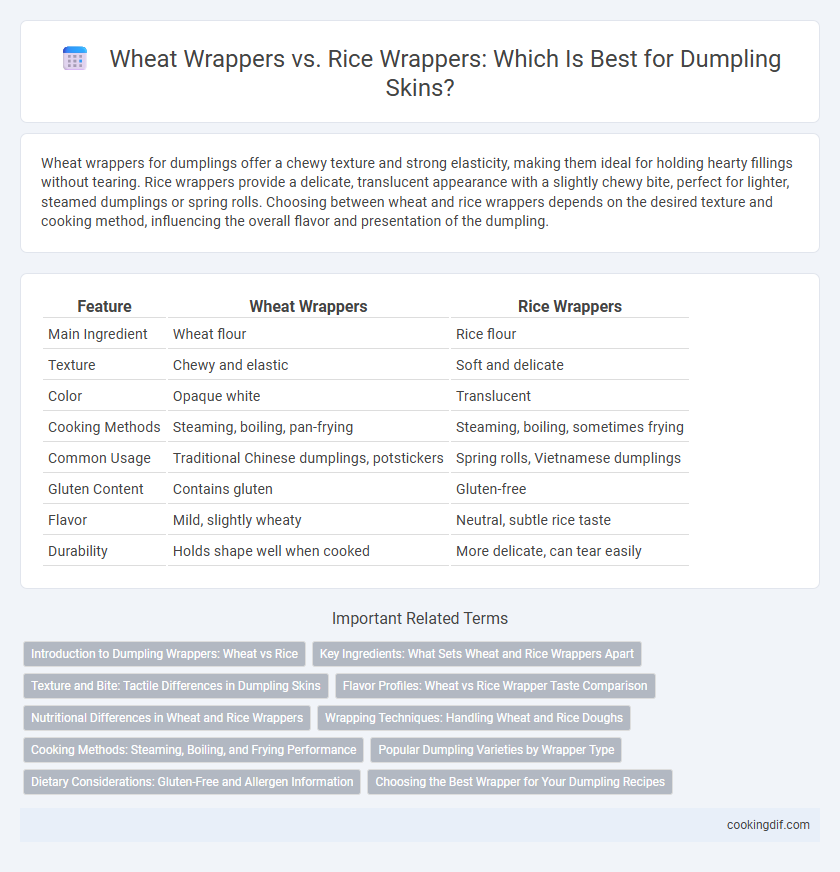Wheat wrappers for dumplings offer a chewy texture and strong elasticity, making them ideal for holding hearty fillings without tearing. Rice wrappers provide a delicate, translucent appearance with a slightly chewy bite, perfect for lighter, steamed dumplings or spring rolls. Choosing between wheat and rice wrappers depends on the desired texture and cooking method, influencing the overall flavor and presentation of the dumpling.
Table of Comparison
| Feature | Wheat Wrappers | Rice Wrappers |
|---|---|---|
| Main Ingredient | Wheat flour | Rice flour |
| Texture | Chewy and elastic | Soft and delicate |
| Color | Opaque white | Translucent |
| Cooking Methods | Steaming, boiling, pan-frying | Steaming, boiling, sometimes frying |
| Common Usage | Traditional Chinese dumplings, potstickers | Spring rolls, Vietnamese dumplings |
| Gluten Content | Contains gluten | Gluten-free |
| Flavor | Mild, slightly wheaty | Neutral, subtle rice taste |
| Durability | Holds shape well when cooked | More delicate, can tear easily |
Introduction to Dumpling Wrappers: Wheat vs Rice
Wheat wrappers are made from wheat flour and water, providing a slightly chewy texture and a neutral flavor that pairs well with various fillings. Rice wrappers, typically made from rice flour or a blend of rice and tapioca starch, offer a translucent, delicate skin often used in steamed or fried dumplings. Choosing between wheat and rice wrappers depends on desired texture and visual appeal, influencing the overall dumpling experience.
Key Ingredients: What Sets Wheat and Rice Wrappers Apart
Wheat wrappers for dumplings primarily consist of wheat flour and water, offering a chewy texture and a neutral flavor that complements various fillings. Rice wrappers are made from rice flour and water, resulting in a translucent, delicate skin with a slightly sweet taste ideal for steamed or fried dumplings. The difference in starch composition between wheat and rice flour impacts elasticity and cooking methods, making wheat wrappers more pliable and rice wrappers more brittle yet crisp.
Texture and Bite: Tactile Differences in Dumpling Skins
Wheat wrappers offer a chewy and elastic texture that provides a satisfying bite, ideal for steamed or pan-fried dumplings. Rice wrappers deliver a delicate, translucent skin with a slightly sticky surface, creating a tender and soft mouthfeel perfect for fresh or fried dumplings. The tactile contrast between wheat's robust elasticity and rice's smooth pliability significantly influences dumpling eating experience and pairing with fillings.
Flavor Profiles: Wheat vs Rice Wrapper Taste Comparison
Wheat wrappers for dumplings offer a chewy texture with a mild, slightly nutty flavor that complements savory fillings like pork and vegetables. Rice wrappers provide a lighter, more delicate texture with a subtle sweetness, enhancing the taste of seafood or fresh vegetable dumplings. The choice between wheat and rice wrappers significantly influences the overall flavor profile, balancing the filling's richness with either hearty or light wrapper notes.
Nutritional Differences in Wheat and Rice Wrappers
Wheat wrappers for dumplings typically contain higher protein and fiber due to the gluten content, which supports better digestion and muscle repair. Rice wrappers are generally lower in calories and carbohydrates, making them a lighter option suitable for gluten-free diets. The glycemic index of rice wrappers is higher, potentially causing a quicker rise in blood sugar compared to the more gradual impact of wheat wrappers.
Wrapping Techniques: Handling Wheat and Rice Doughs
Wheat wrappers for dumplings offer elastic and pliable dough, making them ideal for intricate folding and pleating techniques due to their gluten content. Rice wrappers, made from rice flour, are more delicate and require careful handling to prevent tearing, often softened with warm water to increase flexibility. Mastering the subtle differences in dough elasticity and moisture retention is essential for achieving perfect dumpling shapes and textures with each wrapper type.
Cooking Methods: Steaming, Boiling, and Frying Performance
Wheat wrappers offer a chewier texture and maintain structural integrity during frying, making them ideal for potstickers and pan-fried dumplings. Rice wrappers excel in steaming and boiling due to their delicate, translucent quality, resulting in a tender, smooth skin that absorbs flavors effectively. Choosing between wheat and rice wrappers depends on the desired cooking method and textural outcome, with wheat suited for frying and rice preferred for steaming or boiling.
Popular Dumpling Varieties by Wrapper Type
Wheat wrappers are commonly used in popular dumplings like Chinese jiaozi and Japanese gyoza, providing a slightly chewy texture that holds up well to pan-frying and boiling. Rice wrappers, made from rice flour, are favored in Vietnamese spring rolls and Thai steamed dumplings for their thin, translucent appearance and delicate softness. Each wrapper type complements specific fillings and cooking methods, shaping the unique taste and texture profiles of regional dumpling varieties.
Dietary Considerations: Gluten-Free and Allergen Information
Rice wrappers are naturally gluten-free, making them an ideal choice for individuals with gluten intolerance or celiac disease, whereas wheat wrappers contain gluten and are unsuitable for those with gluten sensitivity. Wheat wrappers may cause allergic reactions in people with wheat allergies, while rice wrappers generally present fewer allergen concerns but can occasionally trigger rice allergies. Choosing between wheat and rice wrappers depends on dietary restrictions and allergen sensitivities, with rice wrappers offering a safer option for gluten and wheat-related dietary considerations.
Choosing the Best Wrapper for Your Dumpling Recipes
Wheat wrappers offer a chewy texture and robust flavor, making them ideal for pan-fried and steamed dumplings that require structural integrity. Rice wrappers provide a translucent, delicate skin perfect for fresh, light dumplings like Vietnamese spring rolls, enhancing the filling without overpowering it. Selecting the best wrapper depends on the desired texture, cooking method, and regional authenticity of your dumpling recipes.
Wheat wrappers vs Rice wrappers for dumpling skin Infographic

 cookingdif.com
cookingdif.com